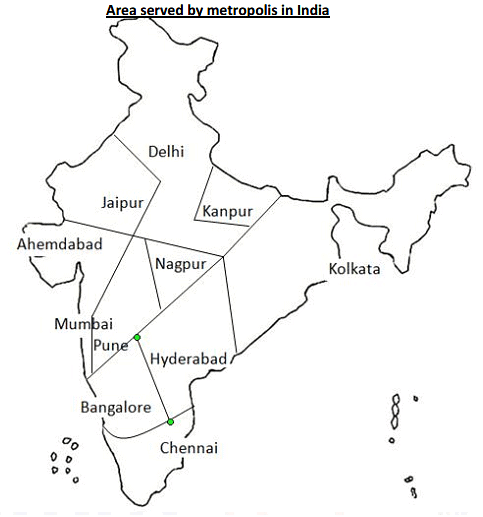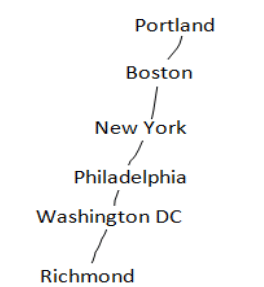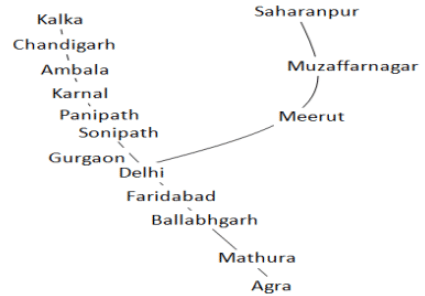Conurbations and Metropolitan Regions | Geography Optional for UPSC PDF Download
The urbanization process is given in the flow diagram below:

Metropolitan regions
- The concept of a "metropolitan city" was first introduced by Murphy, who referred to it as a "metro city," and Mumford, who called it a "metropolitan city." Mumford believed that a metropolis represents one stage in the evolution of urban settlements.
- According to the Census Commission of India, a metropolitan city is defined as one with a population of over 4 million, while the surrounding area of influence is referred to as the Umland. However, a broader definition would include any city with a population of more than 1 million.
- The scope of influence for metropolitan cities is determined based on several factors, including air travel, railway passenger and commodity flows, and long-distance telephone calls.

Current trends
- Current trends show that secondary metropolitan areas are emerging within primary metro regions, with the exception of the Kolkata region. This development is primarily due to linguistic states, and it is expected to accelerate in the future, leading to the rise of new secondary metro centers, particularly state capitals. However, primary metro regions will still maintain their dominant positions. Delhi's prominence will grow disproportionately as it is the national capital.
- At the meso level, several cities are considered primate cities in their respective regions, such as Srinagar in the Kashmir Valley, Shillong in Meghalaya, Aizawl in Mizoram, Agartala in Tripura, Imphal in Manipur, and Gangtok in Sikkim. These cities are gaining importance and influence within their regions, contributing to the overall development of secondary metropolitan areas.
Conurbations
- Conurbations are a concept introduced by Patrick Geddes in his 1915 book, 'Cities in Evolution'. He based the idea on empirical studies of the New England region in the USA. A conurbation refers to the continuous urban growth that occurs along major transportation routes connecting urban centers. This growth typically follows a linear pattern and is connected to a metropolitan or metropolis city.
- A conurbation is a region that consists of multiple cities, large towns, and other urban areas that have merged together through population growth and physical expansion, forming a single, continuous urban and industrial development. This can include various townships, suburbs, satellite towns, and can even connect two or more mega-cities. Conurbations demonstrate significant urban growth along the main lines of urban development and are an integral part of urban ecology, as they are functionally connected to larger urban centers like megalopolises.
- These areas are characterized by their merged growth patterns and the filling in of spaces between existing urban centers. They feature horizontal urban sprawl, massive building structures, hypermarkets, residential communities, and slums adjacent to industrial sectors.
- Conurbations are part of the metropolisation process, which relates to the extensive physical growth of a city into its surrounding areas. Metropolisation not only involves physical expansion but also the merging of various cultures and the emergence of new, predominantly cosmopolitan cultures and lifestyles, reflecting centrifugal forces at play.
- The development of metropolitan cities has been particularly significant since World War II, particularly in developing countries like India, which currently has 35 metropolitan cities. These cities demonstrate high primacy, meaning they are disproportionately larger than other urban centers. As a result, metropolisation contributes to the agglomeration effect, while primacy highlights the polarization and centralization of economic activities.
Some examples
- The most populous Conurbation in the world is the Greater Tokyo Area– comprising of the main cities of Tokyo, Yokohama, Kawasaki, Saitama, and Chiba. This area has largest metropolitan economy in the world.
 Greater Tokyo
Greater Tokyo - The first and the largest (in terms of are) Conurbation of the world may be observed in the eastern sea-board of USA. In this region, there is coalescence of the million cities of Boston, New Haven, New York, Philadelphia, Baltimore, Washington DC, New port, Columbia, and Columbus.
 Eastern Sea Board of USA
Eastern Sea Board of USA - In India, there is huge Conurbation in the process of development from Agra -> Delhi -> Kalka. On branch of this Conurbation moves towards Saharanpur from Delhi.

There are three types of Conurbation in India
In India, there are three types of conurbations or urban areas that consist of multiple cities or towns merging together.
- Uni-nuclear Conurbation: This type of conurbation is the result of a single city's expansion. An example of this is Patna, which is a uni-nuclear conurbation.
- Bi-nuclear Conurbation: This occurs when two growing cities merge with each other, such as Kanpur and Lucknow, which have joined to form a bi-nuclear conurbation.
- Poly-nuclear Conurbation: This involves the merging of more than two cities, like Mumbai, Thane, and Kalyan, which have collectively formed a poly-nuclear conurbation.
Initially, the Delhi Metro Region was a uni-nuclear conurbation. However, it has recently transformed into a poly-nuclear conurbation due to its continuous expansion and the merging of surrounding cities.

- Though India has over 60 conurbations, the concept of conurbation has become outdated in the fields of urban geography, regional science, and regional planning. This idea did not receive much attention from American geographers. Since World War II, the concept of the metropolitan region has gained more prominence. This shift is mainly due to the trend of urban concentration, while the trend of urban sprawl has contributed to the rise of the metropolitan region concept. The latter is more effective for development and planning purposes. However, the notion of conurbation remains relevant for urban sociologists and researchers studying urban behavior, internal migration, and neighborhood interactions.
Megalopolis
- The term ‘megalopolis’ was coined by Gottmann. It reflects the later stage of metropolisation and it is generally studied under urban ecology, which includes the physical morphology and the socio-economic morphology with spatial interactions and the processes resulting in the unprecedented profuse growth of the city.
- Megalopolis =(Metropolisation + Cosmopolisation), and it represents the following characteristics
- High industrial growth
- Centrifugal force
- High growth of service sector
- Isolationism of the society
- Nuclearisation of family
- Luxurious lifestyle
- High consumption (represents Rostov Stage V)
- High per-capita income
- Agglomerative growth pattern
- Development of derived economic sectors.
- Some examples
- London, Paris, Rome, Moscow
- Chicago
- Shanghai, Tokyo
- Sydney, Toronto
Conclusion
In conclusion, the urbanization process involves the growth and development of metropolitan regions, conurbations, and megalopolises. These urban areas are characterized by their massive population size, industrial growth, and the merging of cities and towns. While the concept of conurbation has become outdated in some fields, it remains relevant for studying urban behavior and interactions. The rise of metropolitan regions and megalopolises reflects the increasing urban concentration, industrial development, and cosmopolitan lifestyles in today's world. As urbanization continues to evolve, understanding these different stages and patterns of growth is essential for effective urban planning and regional development.Frequently Asked Questions (FAQs) of Conurbations and Metropolitan Regions
What is the difference between a metropolitan city, conurbation, and megalopolis?
A metropolitan city is a large city with a population of over 1 million or 4 million, depending on the definition. A conurbation is a region consisting of multiple cities, large towns, and other urban areas that have merged together through population growth and physical expansion, forming a single, continuous urban and industrial development. A megalopolis is a later stage of metropolisation, characterized by high industrial growth, centrifugal force, a high growth of the service sector, and other factors resulting in the large-scale growth of the city.
What are the three types of conurbations in India?
In India, there are three types of conurbations: uni-nuclear (a single city's expansion, like Patna), bi-nuclear (two growing cities merging, like Kanpur and Lucknow), and poly-nuclear (more than two cities merging, like Mumbai, Thane, and Kalyan).
What factors determine the scope of influence for metropolitan cities?
The scope of influence for metropolitan cities is determined based on several factors, including air travel, railway passenger and commodity flows, and long-distance telephone calls.
How has the concept of conurbation evolved over time?
Though the concept of conurbation was introduced by Patrick Geddes in 1915, it has become somewhat outdated in urban geography, regional science, and regional planning. Since World War II, the concept of the metropolitan region has gained more prominence, mainly due to the trend of urban concentration and urban sprawl.
What are some examples of megalopolises around the world?
Some examples of megalopolises include London, Paris, Rome, Moscow, Chicago, Shanghai, Tokyo, Sydney, and Toronto. These cities exhibit characteristics such as high industrial growth, a high growth of the service sector, isolationism of society, and a luxurious lifestyle.
|
303 videos|636 docs|252 tests
|
FAQs on Conurbations and Metropolitan Regions - Geography Optional for UPSC
| 1. What is a conurbation? |  |
| 2. What is the difference between a conurbation and a metropolitan region? |  |
| 3. How are metropolitan regions formed? |  |
| 4. What are the advantages of metropolitan regions? |  |
| 5. How are conurbations and metropolitan regions relevant to urban planning and governance? |  |
















